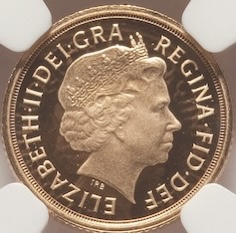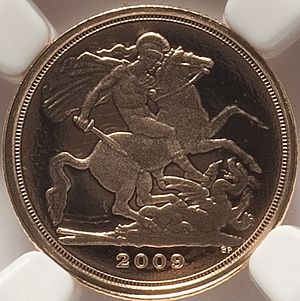Quarter sovereign facts for kids
| United Kingdom | |
| Value | £0.25 pound sterling |
|---|---|
| Mass | 1.997 g |
| Diameter | 13.5 mm |
| Edge | Milled |
| Composition | .917 gold, .083 copper or other metals |
| Gold | .0588 troy oz |
| Years of minting | 2009–present |
| Obverse | |
 |
|
| Design | Reigning British monarch (Elizabeth II shown) |
| Reverse | |
 |
|
| Design | Saint George and the Dragon |
| Designer | Benedetto Pistrucci |
| Design date | 1817 (first used on quarter sovereign in 2009) |
The quarter sovereign is a special British coin. It's made of gold and is mostly for collectors or people who want to own gold. The Royal Mint has made these coins since 2009. It's the smallest coin in the 'sovereign' family and is worth about 25 pence.
Long ago, in 1853, the Royal Mint thought about making a quarter sovereign for everyday use. It would have been worth five shillings. But these coins were never made. People worried they were too small and would wear out quickly. In 2009, gold coins were no longer used for shopping. So, a quarter sovereign was brought back. It joined other sovereign coins like the half sovereign and the five pound gold coin. The quarter sovereign usually has the same design as the bigger coins. This often includes Benedetto Pistrucci's famous picture of Saint George and the Dragon. This design first appeared on the sovereign coin in 1817.
Contents
Early Ideas for a Quarter Sovereign Coin
Why a Small Gold Coin Was Considered
In 1853, the Royal Mint thought about making gold coins worth a quarter sovereign. These were called pattern gold coins and were worth five shillings. At that time, the Mint could not make gold and silver coins at the same time. A small gold coin was seen as a possible choice instead of larger silver coins. In 1853, there was a big need for both gold and silver coins. But the Royal Mint decided to make the more valuable gold coins first.
On March 7, 1853, William Gladstone, who was in charge of the country's money (the Chancellor of the Exchequer), told the House of Commons that there was so much demand for gold that they couldn't make enough silver coins.
Concerns About the Coin's Size
On April 18, 1853, Benjamin Disraeli, a former Chancellor, asked if a quarter sovereign coin had been considered. James Wilson, from the Treasury, said they were trying to make a design. He mentioned a problem: it would take four times longer to make the same amount of gold into quarter sovereigns than into regular sovereigns. Wilson also said the coin would be very small. He compared it to an American one-dollar gold coin, which he held up to show everyone.
By the end of April, Sir John Herschel, who was in charge of the Mint (the Master of the Mint), showed two quarter-sovereign pattern coins. But his report said these coins would be very expensive to make. They also had to be made perfectly. He worried they would wear out quickly because smaller coins get used more often. He also noted that their tiny size would make them easy to lose. Their light weight would also make it hard to spot fake coins. He thought people would lose gold fifteen times faster with these small coins compared to regular sovereigns.
Why the Idea Was Dropped
At that time, a special group in Parliament was looking into using decimal money. Both Herschel and Thomson Hankey, a former head of the Bank of England, spoke to this group. William Miller from the Bank of England also shared his thoughts. All of them were against the quarter sovereign. They worried about how much it would cost to make and keep them in good condition. Because of these concerns, the group did not suggest making the quarter sovereign.
The idea was not pursued further. A writer about coins, G. P. Dyer, thought that Herschel would not have spoken so negatively unless he knew the idea was already going to fail. The new Master of the Mint, Thomas Graham, suggested the quarter sovereign again in 1859. But Gladstone, who was still in charge of money, turned down the idea.
It's important to know that any coins claiming to be quarter sovereigns from 1911 or 1922 are not real. They are modern fakes.
Modern Quarter Sovereign: A Collector's Coin
Return of the Quarter Sovereign
In the early 2000s, the Royal Mint was already making gold coins for collectors. These included sovereigns, half sovereigns, double sovereigns, and five-pound pieces. In 2009, they added quarter sovereigns to this collection. These new coins are not meant to be used for everyday shopping. This meant the old worries from the 1850s about their small size didn't matter anymore. The coin's details and design were officially announced by Queen Elizabeth II (r. 1952 – 2022) on December 10, 2008.
Coin Designs and Changes Over Time
The quarter sovereign does not have its own unique design. Instead, it uses the same designs as the other coins in the sovereign family. Most years, the back of the coin shows Benedetto Pistrucci's famous picture of Saint George and the Dragon. This design first appeared on the sovereign in 1817. The front of the coin always shows the current king or queen.
Other designs have been used too. For example, in 2012, for Queen Elizabeth II's Diamond Jubilee, Paul Day created a new version of the George and Dragon design. Starting in 2015, a new portrait of Queen Elizabeth by Jody Clark was used on some coins. However, in 2016, some coins featured a different portrait of the Queen by James Butler. In 2017, a special version with the original 1817 sovereign design was made. This was to celebrate the 200th anniversary of the modern sovereign coin.
In 2022, the Royal Mint made quarter sovereigns with a new design on the back by Noad. It showed a version of the Royal Arms. This design was used for the Queen's Platinum Jubilee of Elizabeth II. Later that year, after Queen Elizabeth II passed away, the Royal Mint released special memorial coins. These included the quarter sovereign. They featured a version of the Royal Arms by Clark on the back. The front showed the first coin portrait of the new King, Charles III (r. 2022), by Martin Jennings. In 2023, a quarter sovereign was made to celebrate the coronation of Charles III. Its front showed a crowned portrait of the King by Jennings, and the back had the classic Pistrucci George and Dragon design.
How Many Are Made
From 2009 to 2012, the quarter sovereign was sold as a special collector's coin (called a proof coin) and also as a gold bullion piece. The Royal Mint was allowed to make between 50,000 and 250,000 of these, but we don't know the exact number sold. It has been sold as a proof or collector's coin every year. However, only in 2009 did the number made reach 10,000 (with 13,495 coins struck). Both types of the 2022 quarter sovereign were sold as bullion pieces and proof coins. The same is true for the 2023 coronation issue.
See also
Sources


